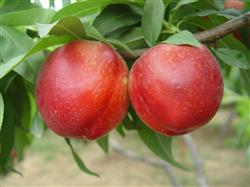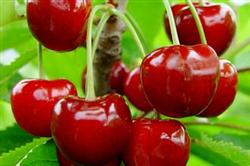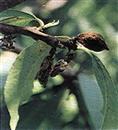Key points of nectarine cultivation techniques

The cultivation techniques of nectarine are basically the same as those of other peach trees, but in order to successfully retain the characteristics of this variety and achieve high and stable yield, the main points of cultivation techniques are as follows: 1. Nectarine site selection has the following characteristics: 1. Nectarine has the characteristics of early germination and flowering, like sunshine, not tolerant to shade, afraid of flooding, not suitable for clayey soil, etc., so we should choose higher temperature, better microclimate, less late frost, leeward and sunny. A plot of loose, fertile soil with good ventilation and drainage. 2. The variety selection of nectarine can be divided into early, middle and late according to the mature stage, and the cultivated varieties can be flexibly selected according to the local market supply. 3. The seedlings can be propagated by grafting and high grafting, and the rootstock is Shanmao peach or sour peach. 4. the pollinated nectarine has a large amount of pollen and strong ability of self-pollination, and cross-pollination can enhance its fruit characteristics, so it can be properly mixed with other nectarines during cultivation, and the fruit quality will be better. 5. It is suitable for planting after soil thawing in spring and defoliation in autumn, and the planting density is 55mur64 plants / mu. The planting method: ditching or large hole planting can be used, and the planting hole requires 80mur60cm. Plant straw 10 kg, farm manure 200 kg, and then layer by layer covered with soil to plant trees, do not apply chemical fertilizer. After planting, the tree is dried immediately according to the shape of the remaining tree, and the tree plate is covered with plastic film. 6. Soil, fertilizer and water management 6.1 soil management. The aim is to create a deep, loose and nutrient-rich soil environment for the root system, which should be fertilized deeply or excavated before the establishment of the garden, and then gradually expand the hole combined with the application of base fertilizer in autumn. Ploughing and weeding. The root system of nectarine is well developed, which requires better ventilation conditions. Ploughing and weeding is carried out many times in the growing season to ensure that the surface is loose and conducive to the rapid growth of nectarine. Reasonable intercropping. In order to improve the light and heat of the land, moisture resources can be properly intercropped, but low-stem and low-crown crops such as green manure, melons and beans, which do not affect growth and development, do not spread related diseases and insect pests, and do not compete with trees for fertilizer and water. 6.2 fertilization. Base fertilizer, mainly farm manure, with calcium superphosphate, in order to plant the second year, the annual application of base fertilizer 150 Mel 200kg; young trees (2murl-4 years) to nitrogen fertilizer, each plant 1 Mel 4 kg, appropriate amount of phosphorus and potassium, into the fruiting period, increasing the ratio of nitrogen, phosphorus and potassium year by year, generally required 2:3:2 is appropriate, and appropriate supplement of other trace elements. 6.3 Irrigation. Areas with annual rainfall of more than 500 mm can not be irrigated, but because our region is relatively dry in spring, in order to ensure normal development or avoid the harm of late frost. It is required to be fully irrigated once in the germination period after thawing and once before freezing. 7. The top advantage of shaping and pruning nectarine tree is relatively strong, there are many branches, the new tree grows faster, the flower bud is easy to form, and it is important to cultivate high-yield tree shape early. The natural happy shape of three main branches and the open heart shape of two main branches are often adopted, but it should be flexibly mastered according to the cultivation mode and density. 7. 1 happy shape. The crown of the tree is relatively tall, the fruiting part can make full use of space, high yield, and is suitable for pure peach orchard. Plastic surgery generally requires two or three main branches, that is, the first main branch is scheduled to be 60 cm from the ground 40 cm from the ground, and the second and third main branches are selected about 20 cm from the first main branch. the remaining main branches are required to be robust, spread evenly in the three directions around the trunk, and all the other branches control their growth and remain as auxiliary branches, and cut the main branches properly when cutting them in winter to expand the crown. About 30 cm per main branch, there were 3 side branches, the other branches were taken weak and strong, the upper side was taken, and the pruning method was pruned far and near. In summer, when the new shoot grew to 40 cm, the heart was removed in time to promote the secondary branches, and the long branches and dense branches on the back were removed to achieve ventilation and light, and the skeleton was cultured early. 7.2 close evacuation stratification. Suitable for fruit tree row belt planting, shaping requires the selection of seven main branches, that is, the first main branch is scheduled to be 40murmur60cm in that year, and the first main branch is left 50cm from the ground, and the distance between main branches is 50cm in the wrong direction. There are 7 main branches left on each main branch, and 3 side branches are left on each main branch, and the rest of the branches are used as auxiliary branches to cultivate, gradually forming the upper and lower structure, which can make full use of the gloss and water between the rows of fruit trees and increase the income per unit area. 7.3 thinning flowers and fruits. The method of "light first and then heavy" can be carried out by stages or in combination with summer shearing. The method is to cut slender flower branches properly, retract drooping flower branches, remove diseased and weak flower branches and dense flower branches, and the first fruit thinning is carried out in the middle of May. mainly remove concomitant fruit, deformed fruit, small fruit and base fruit, tip fruit and so on. The second fruit thinning is carried out from late May to early June. Generally, the long fruit has 3 fruit, the middle fruit branch has 2 fruit, the short fruit branch has 1 fruit, the ratio of leaf to fruit is not less than 50:1, and the fruit spacing is not less than 20 cm. 7.4 bagging. Eastern Gansu is a continental climate, in the nectarine fruit expansion period, often suffer from natural disasters, resulting in nectarine fruit cracking, fruit surface is not clean, the commercial fruit rate decreased greatly. In order to improve the fruit quality of nectarine and achieve green food, bagging technology can make up for many disadvantages and is economical and effective. That is, after fruit thinning in the second and middle of June every year, bagging can be carried out with ordinary single-layer paper bags or plastic bags sold on the market, in the same way as apple bagging technology. 8. Pest control. The main diseases and insect pests of nectarine are: peach anthracnose, brown rot, leaflet disease, peach aphid, leaf mite, leaf miner, etc. To these diseases and insect pests, spraying 5-degree stone sulfur mixture before germination, spraying 2000 times of 10% aphid lice net wettability agent after falling flower, spraying 72% agricultural streptomycin 3000 times and dichlorvos respectively in the first ten days of May and June can control leaflet disease, peach aphid and other diseases and insect pests. After fruit harvest, remove residual fruit, diseased fruit, diseased branches and leaves in time, give priority to prevention, observe and control at any time, to ensure the healthy growth of the tree year-round.
- Prev

Four points for attention in planting big cherry
After trial planting, big cherries like to be warm, not cold-tolerant, not tolerant to drought, not tolerant to waterlogging and afraid of strong wind, so they are suitable for cultivation in areas with an annual average temperature of 10 ℃ ~ 15 ℃. Practice has proved that when the annual average temperature is higher than 15 ℃, big cherries tend to blossom more and set less fruit. Introduction and development of big cherry, not only depends on the local annual average temperature,.
- Next

Management techniques of nectarine in summer
The main diseases and insect pests of nectarine include: peach anthracnose, brown rot, leaflet disease, peach aphid, leaf mite, leaf miner, etc. To these diseases and insect pests, spray 5-degree stone sulfur mixture before germination, spray 2000 times of 10% aphid lice net wettability agent after falling flowers, and spray 72% agricultural streptomycin 3000 times respectively in the middle and last ten days of May.
Related
- Moge, come on! The staff of the peasant association in the producing area of cantaloupe were frightened when the crowd gathered.
- Causes and Solutions of low Fruit setting rate of Apple
- Symptoms and control measures of passion fruit virus disease
- Fruit growing lesson: how do apple orchards keep high yields?
- Can you build orchards in the mountains? What are the pros and cons?
- How to manage the coloring period of Crisson grape?
- This paper introduces the processing technology of two kinds of fig products.
- How much is a month for retired teachers in rural areas by 2020?
- How can strawberry planting increase sugar content? We should pay attention to management in many aspects.
- What are the cultivation techniques on how to improve the yield of golden fruit?

